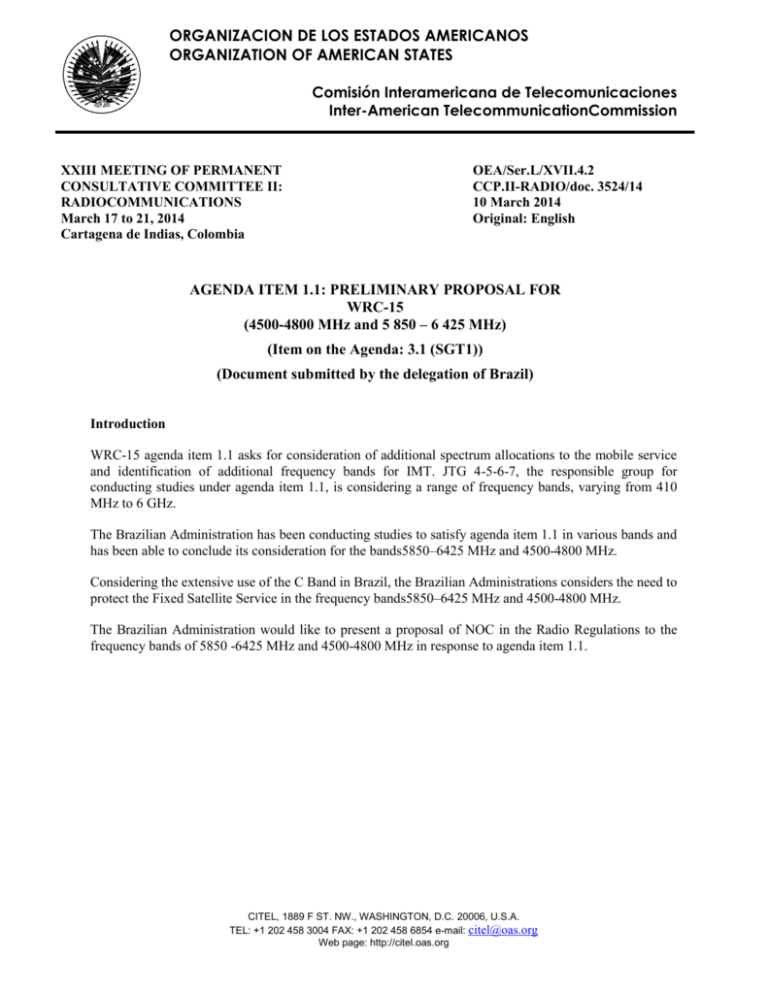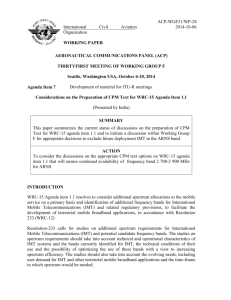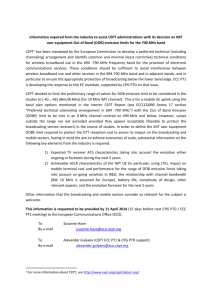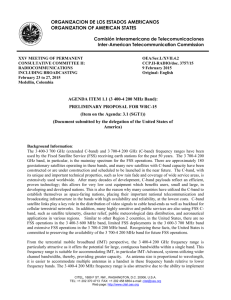citel04679s02
advertisement

ORGANIZACION DE LOS ESTADOS AMERICANOS ORGANIZATION OF AMERICAN STATES Comisión Interamericana de Telecomunicaciones Inter-American TelecommunicationCommission XXIII MEETING OF PERMANENT CONSULTATIVE COMMITTEE II: RADIOCOMMUNICATIONS March 17 to 21, 2014 Cartagena de Indias, Colombia OEA/Ser.L/XVII.4.2 CCP.II-RADIO/doc. 3524/14 10 March 2014 Original: English AGENDA ITEM 1.1: PRELIMINARY PROPOSAL FOR WRC-15 (4500-4800 MHz and 5 850 – 6 425 MHz) (Item on the Agenda: 3.1 (SGT1)) (Document submitted by the delegation of Brazil) Introduction WRC-15 agenda item 1.1 asks for consideration of additional spectrum allocations to the mobile service and identification of additional frequency bands for IMT. JTG 4-5-6-7, the responsible group for conducting studies under agenda item 1.1, is considering a range of frequency bands, varying from 410 MHz to 6 GHz. The Brazilian Administration has been conducting studies to satisfy agenda item 1.1 in various bands and has been able to conclude its consideration for the bands5850–6425 MHz and 4500-4800 MHz. Considering the extensive use of the C Band in Brazil, the Brazilian Administrations considers the need to protect the Fixed Satellite Service in the frequency bands5850–6425 MHz and 4500-4800 MHz. The Brazilian Administration would like to present a proposal of NOC in the Radio Regulations to the frequency bands of 5850 -6425 MHz and 4500-4800 MHz in response to agenda item 1.1. CITEL, 1889 F ST. NW., WASHINGTON, D.C. 20006, U.S.A. TEL: +1 202 458 3004 FAX: +1 202 458 6854 e-mail: citel@oas.org Web page: http://citel.oas.org Agenda Item 1.1: to consider additional spectrum allocations to the mobile service on a primary basis and identification of additional frequency bands for International Mobile Telecommunications (IMT) and related regulatory provisions, to facilitate the development of terrestrial mobile broadband applications, in accordance with Resolution 233 (WRC-12); BACKGROUND: (P2!R-3283-1-1r2_i) Mobile broadband systems, data and applications have become key drivers of global economic growth, job creation and competitiveness. A recently released industry report indicates that global mobile data traffic grew 133 percent in 2011 alone, with mobile video comprising 52% of the traffic.1This dramatic increase in demand for mobile broadband applications has led to a need for additional radio spectrum to support the increasing mobile data traffic. The World Radiocommunication Conference 2012 (WRC-12) recognized this need and adopted WRC-15 Agenda Item 1.1, in an effort to address a looming spectrum shortage for mobile broadband services. WRC-12 (Resolution 233 (WRC-12)) invites the ITU-R to study additional spectrum requirements for IMT, taking into account: Technical and operational characteristics of IMT systems, including the evolution of IMT through advances in technology and spectrally-efficient techniques, and their deployment; the bands currently identified for IMT, the technical conditions of their use, and the possibility of optimizing the use of these bands with a view to increasing spectrum efficiency; the evolving needs, including user demand for IMT and other terrestrial mobile broadband applications; the needs of developing countries; the time-frame in which spectrum would be needed; In addition, the ITU-R is invited to study potential candidate bands, taking into account the results of the study on additional spectrum requirements as well as protection of existing services and the need for harmonization. The Resolution further resolves that the studies include sharing and compatibility studies with services already having allocations in the potential candidate bands and in adjacent bands, as appropriate, taking into account the current and planned use of these bands by the existing services, as well as the applicable studies already performed in ITU-R. According to CPM15-1 Decision on the Establishment and Terms of Reference of Joint Task Group 4-56-7, ITU-R Joint Task Group (JTG) 4-5-6-7 is the responsible group for this agenda item. The group is tasked with developing sharing and compatibility studies as well as draft CPM text. This is to be done taking into consideration the results of studies from ITU-R Working Party (WP) 5D on the spectrum requirements for the mobile service, including suitable frequency ranges, as well as input from any concerned Working Parties on technical and operational characteristics, spectrum requirements and performance objectives or protection requirements of their services. 1 Cisco Visual Networking Index: Global Mobile Data Traffic Forecast Update, 2011-2016. 106731556 12.02.16 1 Several Member States, Recognized Operating Agencies, Scientific or Industrial Organizations and Regional and other International Organizations expressed their views on suitable frequency ranges to satisfy this agenda item, submitting contributions to WP 5D and/or JTG 4-5-6-7. These frequency ranges vary from around 400 MHz to 6 500 MHz, with one Member State proposing suitable frequency ranges over 6 500 GHz. 2 ISSUES: Below are some of the issues that will be addressed in consideration of Preliminary Views and Proposals regarding Agenda Item 1.1. How much spectrum is needed for future Mobile Broadband Application including IMT? Consideration of the time frames for new/existing spectrum to support Mobile Broadband Applications including IMT. Need to take into account more spectrum-efficient techniques. Need to take into account the results of study on additional spectrum requirements, protection of and compatibility with existing services and the need for harmonization, when studying potential candidate frequency bands. Need to accommodate the requirements of developing countries and countries with large areas of low population density. Should potential additional spectrum for different applications be identified separately? 1. FREQUENCY RANGES BETWEEN 3-6 GHz 1.1. BAND 4500 - 4800 MHz ISSUES: The band 4 500-4 800 MHz, allocated to FSS (space-to-Earth), is part of the Appendix 30B FSS Plan, which aims to preserve orbit/spectrum resources and guarantee, for all countries, equitable access to the geostationary-satellite orbit at any-time and anywhere for their use. The use of this band, for the same reasons explained in the 5850-6425 MHz band, such as favorable propagation conditions, continental dimension and the challenges inherent to telecommunication infrastructure in several parts of the country, is of special relevance in a country like Brazil. Coexistence in this band between FSS (Space-to-Earth) and IMT, considering Report ITU-R M.2109 and sharing studies that are being performed at the JTG, seems to be unfeasible due to the large separations needed between receiving earth stations and IMT systems stations. 2 Contribution 5D/257 from Korea 106731556 12.02.16 2 Considering the importance of the planned bands to provide equitable access to the geostationary orbit and that new satellites that will be brought into use in a near future, the Brazilian Administration does not support the inclusion of the 4 500 – 4 800 MHz frequency band as a potential candidate band for IMT. PROPOSAL: NOC B/1.1/1 ARTICLE 5 Frequency allocations Section IV – Table of Frequency Allocations (See No. 2.1) Allocation to services Region 1 Region 2 Region 3 4 500 – 4 800 FIXED FIXED-SATELLITE (space-to-Earth) S5.441 MOBILE Reasons: Due to the existence of earth stations in the region and the importance of the C band for Brazil, it turns out to be unfeasible the allocation of the 4 500-4 800 MHz band to IMT in the region. 106731556 12.02.16 3 1.2. BAND 5850 – 6425MHz ISSUES: Due to the existence of an extensive network of earth stations in the region, particularly in Brazil, it turns out to be unfeasible the allocation of the 5850 – 6425 MHz band to the mobile service in the region. C band, including the Extended C band, is of special relevance in Brazil, as in other countries that, like Brazil, have an extensive continental area. Southern Asia, for its similar meteorological conditions (great rain precipitation) is another world region where C band is extensively used. The use of C band is widespread in Brazil, due to its climate characteristics, associated with its continental dimensions and the lack of telecommunications infrastructure in several parts of the country. This is especially true in the Amazon region, where Internet access would not be possible without the use of trunk links in C band, with connection to the World Wide Web network. Transmitting earth stations operating in accordance with the Radio Regulations have the capability to create interference to IMT systems, and sharing studies have been performed to assess the technical feasibility of deploying IMT-Advanced systems in the 5 850–6 425 MHz band using the latest IMTAdvanced characteristics provided by WP 5D to the JTG. These sharing studies show separation distances in the range of tens of kilometers that, considering the widespread deployment of FSS earth stations in Brazil, coexistence would turn out to be unfeasible. Additionally, FSS satellite systems must also be protected. Aggregate interference from IMT stations into any satellite station, independently of the country deploying IMT systems, should also be considered to ensure FSS protection in the long term. In Brazil there are over 8,000 registered C band earth stations pointing to Brazilian satellites and over 12,000 registered stations pointing to foreign satellites that cover Brazil, in the frequency band 5925 – 6425 MHz. This number doubles once we include the Extended C band (5850-5925 MHz). There are currently 10 Brazilian satellites and 27 foreign satellites duly authorized to operate in C band in Brazil. Many of those authorizations have extended validity to over 2024. This duly demonstrated extensive use of and high demand for C band reflect the important role of national integration that this frequency band still plays in Brazil. Considering the extensive used of C band in Brazil and the distances required between IMT stations and FSS earth stations from sharing studies, sharing of both services seems unfeasible in uplink C band. Therefore, the Brazilian Administration does not support the inclusion of the 5 850-6 425 MHz frequency band as a potential candidate band for IMT. 106731556 12.02.16 4 PROPOSAL: NOC B/1.1/2 ARTICLE 5 Frequency allocations Section IV – Table of Frequency Allocations (See No. 2.1) Allocation to services Region 1 5 850 – 5 925 FIXED FIXED-SATELLITE (Earth-to-space) MOBILE Region 2 5 850 – 5 925 FIXED FIXED-SATELLITE (Earth-to-space) MOBILE Amateur Radiolocation S5.150 S5.150 5 925 – 6 700 FIXED FIXED-SATELLITE (Earth-to-space) MOBILE Region 3 5 850 – 5 925 FIXED FIXED-SATELLITE (Earth-to-space) MOBILE Radiolocation S5.150 S5.149 S5.440 S5.458 Reasons: Due to the existence of an extensive network of earth stations in the region, particularly in Brazil, it turns out to be unfeasible the allocation of the 5850-6425 MHz band to IMT in the region. 106731556 12.02.16 5






